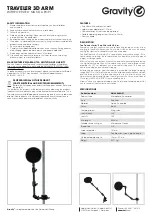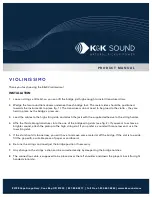
Section 3
3
5 Laser Systems Safety Warnings
9
Research Instruments Ltd
Emissions test
Compliance
Electromagnetic environment -
guidance
RF emissions
CISPR 11
Group 1
The Saturn 5 Laser System uses
RF energy only for its internal
function. Therefore, its RF
emissions are very low and are
not likely to cause
any interference in nearby
electronic equipment.
RF emissions
CISPR 11
Class B
The Saturn 5 Laser System
is suitable for use in all
establishments, including
domestic establishments and
those directly connected to
the public low-voltage power
supply network that supplies
buildings used for domestic
purposes.
Harmonic emissions
IEC 61000-3-2
Class A
Voltage fluctuations/flicker
emissions
Complies
Guidance and Manufacturer’s Declaration – Electromagnetic Emissions (IEC 60601-1-2)
The Saturn 5 Laser System is intended for use in the electromagnetic environment specified below. The
customer or the user of the Saturn 5 Laser System should assure that it is used in such an environment.
*Kanyo, K., Konc, J. “A follow-up study of children born after diode laser assisted hatching.” European
Journal of Obstetrics and Gynaecology. 110: 176-180 (2003).
Precautions
•
To minimise the risk of damage to blastomeres, administer as few laser pulses as possible at the
lowest energy levels possible to achieve the prescribed zona drilling or thinning effect.
•
Direct the laser beam toward a section of the zona pellucida where the adjacent perivitelline space
is widest or next to an area of fragmentation.
•
A holding pipette should be used during laser treatment to minimise the risk of embryo movement.
•
Small openings in the zona pellucida may lead to embryo constriction and abnormal development.
•
To date there are no known reports showing a greater occurrence rate of major or minor defects
in children derived from laser-hatched embryos. Long-term follow-up data on children born from
laser-hatched embryos does not yet exist. A study of 134 such babies* found no increase in the major
congenital malformations, chromosomal aberrations or minor congenital malformations between
the LAH treated group and all deliveries at their hospital.
•
The device is not affected by and does not present any reciprocal interference to the microscope.
•
During normal use there is no contact with patient/sample.










































